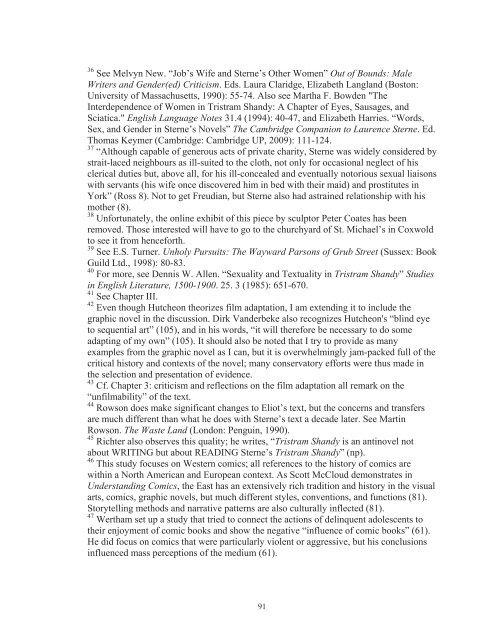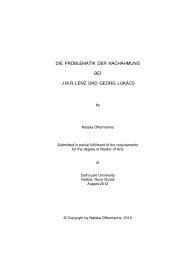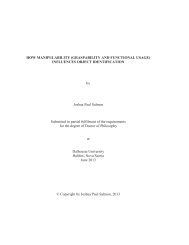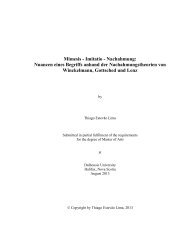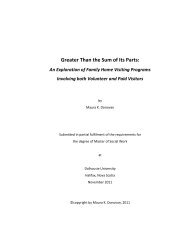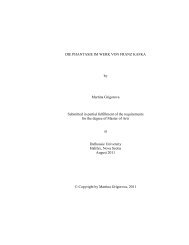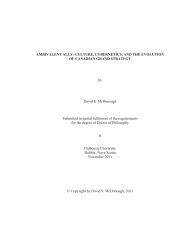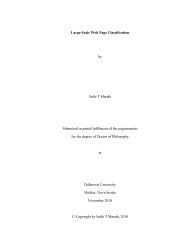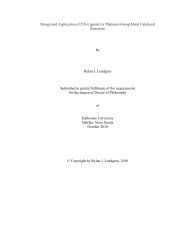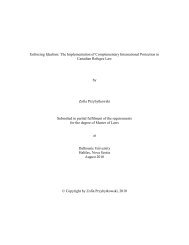ADAPTING TRISTRAM SHANDY by Adria Young Submitted in ...
ADAPTING TRISTRAM SHANDY by Adria Young Submitted in ...
ADAPTING TRISTRAM SHANDY by Adria Young Submitted in ...
You also want an ePaper? Increase the reach of your titles
YUMPU automatically turns print PDFs into web optimized ePapers that Google loves.
36 See Melvyn New. “Job’s Wife and Sterne’s Other Women” Out of Bounds: Male<br />
Writers and Gender(ed) Criticism. Eds. Laura Claridge, Elizabeth Langland (Boston:<br />
University of Massachusetts, 1990): 55-74. Also see Martha F. Bowden "The<br />
Interdependence of Women <strong>in</strong> Tristram Shandy: A Chapter of Eyes, Sausages, and<br />
Sciatica." English Language Notes 31.4 (1994): 40-47, and Elizabeth Harries. “Words,<br />
Sex, and Gender <strong>in</strong> Sterne’s Novels” The Cambridge Companion to Laurence Sterne. Ed.<br />
Thomas Keymer (Cambridge: Cambridge UP, 2009): 111-124.<br />
37 “Although capable of generous acts of private charity, Sterne was widely considered <strong>by</strong><br />
strait-laced neighbours as ill-suited to the cloth, not only for occasional neglect of his<br />
clerical duties but, above all, for his ill-concealed and eventually notorious sexual liaisons<br />
with servants (his wife once discovered him <strong>in</strong> bed with their maid) and prostitutes <strong>in</strong><br />
York” (Ross 8). Not to get Freudian, but Sterne also had astra<strong>in</strong>ed relationship with his<br />
mother (8).<br />
38 Unfortunately, the onl<strong>in</strong>e exhibit of this piece <strong>by</strong> sculptor Peter Coates has been<br />
removed. Those <strong>in</strong>terested will have to go to the churchyard of St. Michael’s <strong>in</strong> Coxwold<br />
to see it from henceforth.<br />
39 See E.S. Turner. Unholy Pursuits: The Wayward Parsons of Grub Street (Sussex: Book<br />
Guild Ltd., 1998): 80-83.<br />
40 For more, see Dennis W. Allen. “Sexuality and Textuality <strong>in</strong> Tristram Shandy” Studies<br />
<strong>in</strong> English Literature, 1500-1900. 25. 3 (1985): 651-670.<br />
41 See Chapter III.<br />
42 Even though Hutcheon theorizes film adaptation, I am extend<strong>in</strong>g it to <strong>in</strong>clude the<br />
graphic novel <strong>in</strong> the discussion. Dirk Vanderbeke also recognizes Hutcheon's “bl<strong>in</strong>d eye<br />
to sequential art” (105), and <strong>in</strong> his words, “it will therefore be necessary to do some<br />
adapt<strong>in</strong>g of my own” (105). It should also be noted that I try to provide as many<br />
examples from the graphic novel as I can, but it is overwhelm<strong>in</strong>gly jam-packed full of the<br />
critical history and contexts of the novel; many conservatory efforts were thus made <strong>in</strong><br />
the selection and presentation of evidence.<br />
43 Cf. Chapter 3: criticism and reflections on the film adaptation all remark on the<br />
“unfilmability” of the text.<br />
44 Rowson does make significant changes to Eliot’s text, but the concerns and transfers<br />
are much different than what he does with Sterne’s text a decade later. See Mart<strong>in</strong><br />
Rowson. The Waste Land (London: Pengu<strong>in</strong>, 1990).<br />
45 Richter also observes this quality; he writes, “Tristram Shandy is an ant<strong>in</strong>ovel not<br />
about WRITING but about READING Sterne’s Tristram Shandy” (np).<br />
46 This study focuses on Western comics; all references to the history of comics are<br />
with<strong>in</strong> a North American and European context. As Scott McCloud demonstrates <strong>in</strong><br />
Understand<strong>in</strong>g Comics, the East has an extensively rich tradition and history <strong>in</strong> the visual<br />
arts, comics, graphic novels, but much different styles, conventions, and functions (81).<br />
Storytell<strong>in</strong>g methods and narrative patterns are also culturally <strong>in</strong>flected (81).<br />
47 Wertham set up a study that tried to connect the actions of del<strong>in</strong>quent adolescents to<br />
their enjoyment of comic books and show the negative “<strong>in</strong>fluence of comic books” (61).<br />
He did focus on comics that were particularly violent or aggressive, but his conclusions<br />
<strong>in</strong>fluenced mass perceptions of the medium (61).<br />
91


